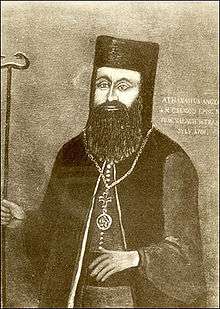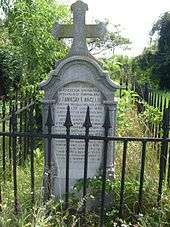Atanasie Anghel
Atanasie Anghel Popa (born in Bobalna, Hunedoara – died 19 August 1713, in Alba Iulia) was a Romanian Greek-Catholic bishop of Alba Iulia between 1698 and 1713. He was the successor to Teophilus Seremi in the seat of Mitropoliei Bălgradului (Alba-Iulia). Through his continued efforts, he perfected the union of the Romanian Transylvanians with the Catholic Church.[1][2][3]
Atanasie Anghel Popa | |
|---|---|
| Primate of the Romanian Greek Catholic Church | |
 | |
| Church | Romanian Greek Catholic Church |
| Diocese | Diocese of Alba Iulia |
| Installed | 22 January 1698 |
| Term ended | 19 August 1713 |
| Predecessor | Teophilus Seremi |
| Successor | Ioan Giurgiu Patachi |
| Personal details | |
| Died | 19 August 1713 Alba Iulia |
Life
He was the son of an Orthodox priest from Bobâlna (today in Hunedoara county) who was a nobleman of Ciugud.[4]
Anghel was ordained bishop on January 22, 1698, by Eastern Orthodox Metropolitan Teodosius (1620-1708), Primate of the Metropolitan diocese of Ungro-Wallachia and by Patriarch of Jerusalem Dositheos II (1641-1707), who was in exile.[5]
Patriarch Dositheos II also asked Bishop Atanasie Anghel to listen to both the Greek hierarchs from the court of voivode Constantin Brâncoveanu,[6] who supervised the work of the Romanian hierarchs[7] and the Transylvanian Calvinist hierarchy.
First synod of Alba Iulia

On 7 October 1698 he convened the "Union Synod" in Alba Iulia. The Act of Union with the Catholic Church was signed not only by Atanasie Anghel, but by all members of the Synod (38 district protopopes[8] and 2270 priests), and sealed with the seal of the Metropolitan Archbishopric of Alba Iulia (Mitropolia Bălgradului in old Romanian language). The Transylvanian Diet, controlled by Protestants, did not look favorably upon the confessional issues of the Romanian people. Large land holders began to persecute the new Romanian Greek-Catholic priests, a situation which Atanasie Anghel had to cope with. Protestant noblemen encouraged revolts among peasants opposed to joining the Catholic Church.
Under these circumstances, the bishop Atanasie Anghel convened a new synod, also held at Alba-Iulia on 4 September 1700. This was attended not only by protopopes and priests, but also by 3 laymen delegates from each Romanian village. The 54 protopopes, together with the priests and all the delegations present, signed a new act which reinforced the decision of the synod of 1698, reaffirming religious unification of Romanians in Transylvania with the Catholic Church.
For Greek-Catholic bishop Atanasie Anghel, there followed years of hardship, being attacked by Calvinists and also by the Orthodox Archdiocese of Bucharest. Atanasie was summoned to Vienna to give explanations. Under these circumstances, on 7 April 1701 he made a statement that he no longer recognized the Archbishop of Bucharest as his superior.
Business activities
Metropolitan Athanasius was accused several times of carrying out commercial activities. Fifteen years before joining Rome he bought a house in Alba Iulia where he brewed beer and wine. In 1703, after the union with Rome, he was summoned to cease this activity, considered incompatible with the status of bishop.[9] In 1711, he still earned income from beer production.[10]
Death
Anghel died in Alba Iulia on August 19, 1713, being buried near the old church of the Bălgrad Metropolitanate (built by the ruler Mihai Viteazul). Subsequently, with the construction of the Alba Carolina Citadel, the old church was demolished, and the tomb of Atanasie was moved to the cemetery near the Holy Trinity Church in Alba Iulia.
In 2013, the remains of Atanasie Anghel were moved to the Holy Trinity Cathedral, Blaj.[11]
Literature
- Octavian Bârlea: Atanasie, Anghel Popa, in "Biographical Encyclopedia on the History of Southeastern Europe". Bd. 1 Munich 1974, pp. 106–108.
- Roman Catholic, Transylvanian, Protestant and Israeli religious archontology. Compiled by György Jakubinyi. Rev. 3 and Exp. edition. Cluj: Verbum. 2010. 58–68. He. ISBN 978-606-8059-25-9.
Notes
- Cârnaţiu, Pamfil (1998). Biserica Română Unită două sute cincizeci de ani de istorie. 1. Cluj-Napoca. pp. 25–31. ISBN 973-9288-11-1.
- "Episcopul Atanasie Anghel Popa". BRU. Archived from the original on 17 May 2011. Retrieved 17 April 2011.
- [Silvestru Augustin Prunduş, Clemente Plăianu: Catholicism and Romanian Orthodoxy. Short history of the Romanian United Church. Christian Life Publishing House, Cluj 1994.]
- [John M. Bota, History of the Universal Church and the Romanian Church from its origins to today, p. 162.]
- [Timotei Cipariu, Acts and Fragments, Blaj, 1855, p. 210.]
- [Onisifor Ghibu, Rost of the Patriarch of Dositei of Jerusalem in Romania, as an enemy of the Romanian people and of the Romanian language and culture, in the Society of tomorrow, Nr. 28, Cluj, 1924, p. 556]
- [Nicolae Iorga, History of the Romanian Church, vol. 2, Bucharest, 1930, p. 16.]
- [The signatures of the 38 protopopes were verified and authenticated by Silviu Dragomir, Romanians from Transylvania and the Union with the Church of Rome, Cluj, 1990, p. 35.]
- [A. Bitay, An Outstanding Nothing in the Life of Atanasie Anghel, in: Historical Review XXI (1935), pp. 21-22.]
- [Nicolae Iorga, Two letters of Atanasie Anghel in: Romanian Academy. Memoirs of the Historical Section, Series III, Volume XIII (1933), pp. 7-8.]
- adevarul.ro